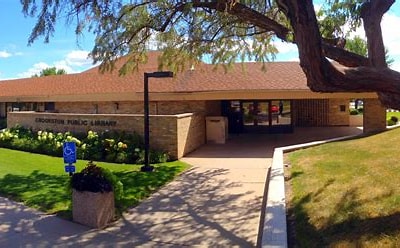On Monday, the Crookston City Council passed a motion to have the Minnesota Department of Transportation (MnDOT) craft a Joint Powers Agreement to conduct a study of 14 blocks along the Highway 2 corridor in downtown Crookston along with additional blocks on South Main and South Broadway to the Red Lake River.
 The City Council again questioned whether it would be wise to include the streets between Main and Broadway such as Second, Loring, and Fletcher in the study. However, both city and MnDOT staff, who attended the meeting virtually over Zoom, thought their inclusion would be prudent. MnDOT District 2 Project Manager Matt Upgren said the corridor study was a monumental task itself and that MnDOT worried side issues that came up on those streets could bog things down. “Evaluation of those roadways was complex enough, controversial enough, we felt it warranted an actual corridor studio,” said Upgren. “To do a corridor study is kind of the platinum package – the best, most detailed analysis of your corridor we could provide. As we talk about these side streets, our own opinion is the city side streets, for example, don’t warrant that level of scrutiny or intent research and analysis that the rest of the study would get from a traffic operation or pedestrian movement standpoint. A state engineer could probably talk through some of those changes needed on the side streets and save a fair amount of money.”
The City Council again questioned whether it would be wise to include the streets between Main and Broadway such as Second, Loring, and Fletcher in the study. However, both city and MnDOT staff, who attended the meeting virtually over Zoom, thought their inclusion would be prudent. MnDOT District 2 Project Manager Matt Upgren said the corridor study was a monumental task itself and that MnDOT worried side issues that came up on those streets could bog things down. “Evaluation of those roadways was complex enough, controversial enough, we felt it warranted an actual corridor studio,” said Upgren. “To do a corridor study is kind of the platinum package – the best, most detailed analysis of your corridor we could provide. As we talk about these side streets, our own opinion is the city side streets, for example, don’t warrant that level of scrutiny or intent research and analysis that the rest of the study would get from a traffic operation or pedestrian movement standpoint. A state engineer could probably talk through some of those changes needed on the side streets and save a fair amount of money.”
City Administrator Amy Finch also shared that the city staff is prepared to put a sidewalk maintenance program into place to address some concerns with pavers. However, the details of that proposal were withheld for a future meeting. “The other part of that discussion we have visited about at length was some of the paver issues on some of the side streets like Second and Third Street,” said Finch. “What we agreed to this evening was to set that aside as a separate city issue to work with our staff and engineer to determine a plan to bring back to them later.”
Councilman Wayne Melbye made a motion that received unanimous approval to move forward with the joint powers agreement to include approximately six city blocks along with the 14 blocks proposed by MnDOT. Finch estimated the additional city blocks would cost about half that of the MnDOT blocks would cost MnDOT to have studied, which MnDOT estimates will be approximately $100,000. Melbye said the study will provide options for slowing traffic and safety. “We have a tough corner down there on East Robert,” said Melbye. “And with the three lanes of traffic on both Main and Broadway, they are going to try to tell us what we can do to get things a little more fluid, things to maybe be slowed a little for downtown traffic, and work with the sidewalks down there. They’re going to give us some different projects that we can do. We can pick and choose which ones we want and see which way we want to go. It’s safety first and all that good stuff, and then, beautify downtown.”
The sidewalk maintenance proposal was met with some questions, notably from Councilman Steve Erickson, who owns a business on Second Street. He said Council had previously been told replacing sidewalk pavers with concrete wasn’t an option before. “I guess my concern was if we’re going to do this project, we can’t forget about the side streets which host businesses need to be addressed,” said Erickson. “That’s been an issue since I’ve been on the Council. Six years ago, we brought it up about repairing them. Pulling up bricks was not an answer, but now we’re going to cement them and redo them one at a time, or so much a year. I want to make sure they don’t get lost in the shuffle.”
Public Works Director Pat Kelly said the difference would be undertaking paver maintenance vs. a full sidewalk project as they’d replace sections where the pavers had deteriorated and that the city no longer had a supply of pavers to replace them with. “We’re looking at kind of a maintenance project to look at the pavers that are seriously deteriorating on some of these side streets,” said Kelly. “It’s getting to a point where trying to replace them is getting so labor-intensive, and we’re running out of bricks and that too. So, we thought we’d try a maintenance project with just removing the pavers and installing concrete in a ribbon similar to what they did at Bremer with that pinkish concrete. We’d go with just the regular gray concrete and try to get rid of some of those trip hazards that are forming. At least give us a bandaid, until if nothing else, this corridor study is completed, and we look to see what kind of dollars we’re looking at for different projects.”
Finch also noted staff believed the side streets don’t have the same Americans with Disabilities Act (ADA) compliance issues with slopes present on Main and Broadway. Kelly identified a couple of areas that could be the first to be addressed, including Second Street, where he estimated the pavers could be replaced with concrete for under $5,000. “Certainly, some of the pavers on Second Street are looking kind of tough,” said Kelly. “And then, there is a stretch over on South Main by KROX and the animal hospital (Crookston Pet Clinic) and that area that are seriously deteriorating. We’re probably looking this year at getting Second Street between Main and Broadway as a goal of ours if we move forward.”
SUMMARY OF CLOSED MEETING FOR LAND PURCHASE AND ACTION TAKEN AFTER
The City of Crookston also provided a summary of the March 8 closed session on the possible purchase of two parcels from Bob Herkenhoff and a summary of the action taken after that meeting. Finch provided an overview of that discussion. “In the closed meeting, many things were discussed, such as purchase price,” said Finch. “And then, talked about the impact of some future development cost. Part of that discussion included a wetland designation that was pulled off of the state website. I think it was the U.S. Wildlife website. What our advice was from our engineer was, really, to determine the impact of wetlands, a delineation needs to be completed. That’s a more formal process where they go out and check for certain types of plants growing. It can’t be done until growing season.”
Finch added that the City Council had a consensus for a delineation to be conducted and paid for by Herkenhoff. “The consensus from the Council was to ask the seller to allow the city to do a delineation during the growing season as soon as we could, but hold the sale of that land until that could be completed, and ask the seller to pay the purchase price of that delineation which is estimated to be between $3,000-5,000 for the delineation and report,” said Finch. “That request was conveyed to the seller and was not accepted. And no counter-proposal was offered. At that point, without the delineation, our engineer felt he was unable to say what a development layout could look like without fully understanding and having the delineation on what the wetland impact would be – how you would mitigate, avoid, or minimize those issues. At this point, there will be no further action on the city’s part because there was no counter-proposal to consider.”
Additionally, in the summary of the closed session, mitigation requires wetland credits, which the summary estimated to be between $13,000-17,000 an acre. There is a wetland credit storage in Minnesota, and those credits can push $19,000 or more to purchase from the landowner holding them.
The two parcels being looked at were adjacent to the city’s recent infrastructure as part of various developer’s agreements for Nature View Estates. Asked whether wetlands were a concern in the city’s agreements for that development, Finch explained why potential wetland delineation in that area didn’t fall under the City of Crookston’s scope for those projects. “Because the city was simply acting as more of a contractor with the putting in of the road, it would’ve been on the owner of the property to do the delineation,” said Finch. “The owner has to provide the authority to do that. A contractor, such as the city providing utilities, wouldn’t have had the authority to do that. And the onus would always be on the owner or developer to check that. So, the city would not have been a part of that process on the other development.”
The written summaries are below.
ELECTRONIC MEETING PARTICIPATION ORDINANCE
An ordinance was also introduced Monday to amend the City Code policy for electronic participation in meetings as authorized under the City of Crookston Charter Section 3.02 here. Finch said the ordinance will formalize the process for electronic participation in city meetings. “Our Charter, I believe in Chapter 3, allows the City Council to hold meetings by any means of communication as long as the members and other participants can hear (and see) each other,” said Finch. “With our new video/audio system that does allow both of those things, we’d like to have the ordinance introduced. Hopefully, it will be adopted by City Council. If a City Council member is unable to attend in person, it allows that option for them to attend virtually, somebody participating in a presentation, wanting to attend a public hearing, or even to provide comment on the public forum would be allowed to use that. It just sets up and formalizes that process for us to move forward with that.”
The second reading and passage of the ordinance will be scheduled for the next City Council Meeting on April 12. The ordinance is available here.
CONSENT AGENDA AND RESOLUTIONS
The City Council’s consent agenda of the March 8 meeting minutes, bills and disbursements totaling $262,178.11, and the extension of the local emergency due to COVID-19. They passed a resolution approving the City Administrator’s spending authority to include approved budget items exceeding the $10,000 general spending authority as was discussed here.
Two resolutions were passed on recommendation from the Planning Commission. One to approve a cash farm lease for 90 acres on the Colborn Property, and the other to reconvey two tax-forfeited parcels to the State of Minnesota as discussed here. The final resolution was to transfer one-third of the net revenue from the sale of 10 acres of the Colborn Property to the Ag Innovation Campus to the Crookston Housing and Economic Development Authority (CHEDA) per the Contribution Agreement drafted during the purchase of the property with Crookston Jobs and transferred to CHEDA with the liquidation and dissolution of Crookston Jobs in June 2017. The total approved transfer was $17,572.44.
[embeddoc url=”https://kroxam.com/wp-content/uploads/2021/03/Summary-of-Property-Purchase-Meeting-and-Action.pdf”]
Tags:


